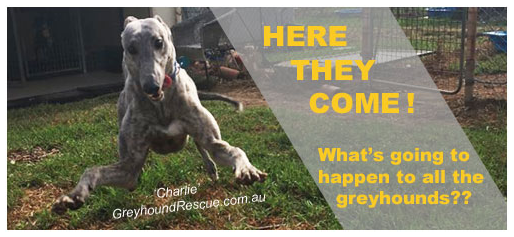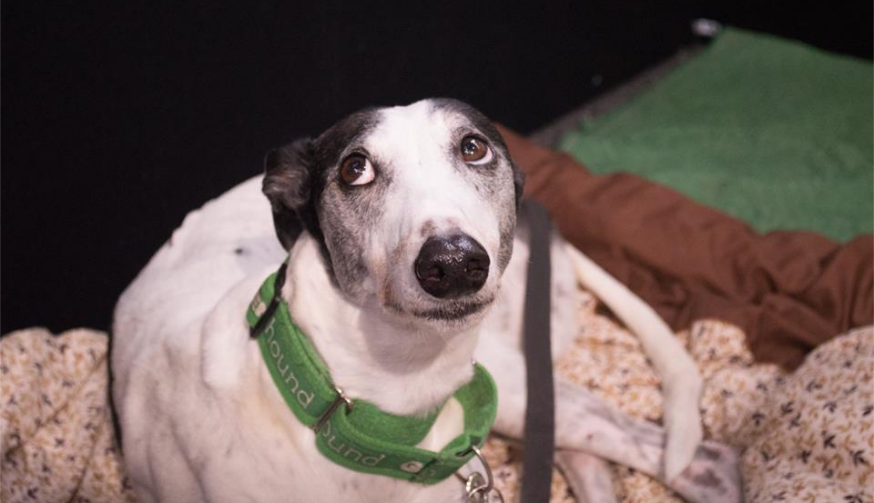Greyhounds as Pets
Greyhounds that are retired from racing are just like all other dogs but of course they have some unique characteristics. They are generally very intelligent and sensitive dogs, that are also gentle and sociable. Greyhounds adapt to life as family pets well.
How well does a retired racer adapt to family life?
Most retired racing Greyhounds will adapt very quickly to life as your close companion or a family pet. Following the stresses of racing - both physical and emotional, greyhounds tend to move easily into a cosy lazy family life. Keep in mind that most will not have been in a home before so things like mirrors, vacuum cleaners, televisions, stairs, slippery floors, mirrors and glass doors will be new. Because they are very clean naturally, house training is generally not a problem once there's a daily routine. Most Greyhounds love travelling in cars, but because of their long bodies and high centre of gravity, some find it difficult to balance in normal sedans and travel best in hatchbacks or station wagons.
Are Greyhounds OK with children and other pets?
While racing, many greyhounds never experience other dog breeds or small animals like cats, rabbits and guinea pigs. Because they have been bred to hunt, they have a strong instinct to chase. Most Greyhounds will mix well with other dogs but they need to be introduced appropriately. Some retired dogs will get along well with cats; while others are too 'keen' to live successfully with them. Greyhounds are generally very gentle with children, prefering to walk away from a pestering child; but remember that young children (especially those under five) should never be left alone and unsupervised with any breed of dog.
How big are Greyhounds?
Male Greyhounds range from 67 - 72cm in height and approx. 30 - 35 kg in weight. Bitches are generally smaller, at 62 - 68 cm and 24 - 30 kg.
Alot of people think that the size of greyhounds makes them difficult as pets. But they really don't take up a lot of 'space' physically or energetically, and don't tend to get in the way and under your feet. Despite their size, greyhounds can curl up quite neatly in a small cosy corner. Because they spend most of their time sleeping and relaxing, their size is of no consequence.
Greyhounds seem to take up alot less space than a very busy /active small dog. Many families with small inner city apartments and terraces confirm that their greyhounds ar more than happy lounging in a cosy spot and don't need a lot of room at all.
Do Greyhounds need a lot of exercise?
Despite popular belief, and the fact that they can run as fast as they do, greyhounds do not actually require alot of exercise. They can be perfectly healthy and happy with just one twenty minute walk a day. Greyhounds like to find a cosy place in the house - usually the couch or a bed, and are very happy to sleep most of the day.
Are Greyhounds good guard dogs?
Greyhounds usually only bark if they are very excited about something or if something is wrong. They otherwise rarely bark so if you're looking for a guard dog a greyhound probably isn't the breed you're after. They are very observant and will watch and notice everything but that's about as far as they go. Most greyhounds are friendly and greet most strangers as friends. Some individuals are a little more aloof when in the company of strangers.
Is a male or a female greyhound better as a pet?
The Greyhound Adoption Program (NSW) (GAPNSW) find that many people are concerned about issues in male greyhounds like dominance or aggression, "leg cocking" and overall size. For these reasons people often prefer to choose female dogs. These views are very common and are often based on people's experience with other breeds. Because of this, there is often long waiting lists for females and very little interest in males. This is very unfortunate for obvious reasons, and particularly because male greyhounds are often even more soft natured than females.
GAPNSW also say that in their experience male greyhounds rarely attempt to dominate other dogs, whether male or female - and if anything, the females are more confident and "forward" than the males.
Male greyhounds are very clean and don't cock their legs on furniture or indoor plants. They also don't have the need to mark every tree when out walking like many other breeds. Some males actually don't cock their leg at all, but apparently some females do!
Please consider a boy if you've decided to share your life with a Greyhound. The waiting time will almost undoubtedly be shorter and you will end up with wonderful companion who has none of the problems that you may have expected to come with a male dog.
What is a "sighthound"?
The Greyhound is built for sprinting over short distances and is a very strong and muscular dog, . Except for the cheetah, the Greyhound is the fastest animal on earth. The breed belongs to the sighthound (or gazehound) group which also includes Afghans, Deerhounds,Borzoi, Irish Wolfhounds, Salukis, Whippets, Pharaoh Hounds etc. These breeds use sight rather than sent to hunt their quarry. Their natural quarry is the hare.
How long do Greyhounds live?
The average lifespan of a greyhound is 10-12 years and they truly grow old gracefully.
The greyhound coat
Greyhounds have a very soft, fine coat. This, together with their low body fat, means that they tend to feel extremes in temperature more than most dogs (both heat and cold). Don't be surprised if on cold nights your greyhound will most likely want to snuggle with you under the doona!
Greyhounds come in a vast array of coat colours: black, white, red, blue, fawn, brindle, or any of these colours broken with white. Despite their name, grey (or blue as it is known) is not a very common colour in the breed.
Can my Greyhound be trained to obey my
Greyhounds rarely pull as they are used to walking on a lead and generally heel well. They will rarely if ever sit, however, unless they are taught. They prefer to stand or lie down. Greyhounds are very intelligent and will learn new commands or exercises quickly but they can be easily distracted or bored. Obedience training is important for any dog being adopted into a new home. However, for the aristocratic and sensitive greyhound, only gentle training methods and positive reinforcement should be used. A greyhound shouldn't be allowed to run off lead unless in a fully fenced and safe area. Their great speed and complete lack of traffic sense means they are at serious risk if they are near roads.
Greyhounds and muzzles
Under current NSW law, Greyhounds are required to be muzzled in a public place, except if they are being exhibited for show purposes or participating in an obedience trial. A recent change to the NSW regulations has allowed Greyhounds tested and passed by the Greyhound Adoption Program National Temperamant Test to go without muzzles as long as they wear a distinctive green collar.
From a racing dog to a member of the family
Dogs accepted into the The Greyhound Adoption Program (NSW) go through a series of health checks and a rehabilitation process before they are ready to go to their new homes. Most retired greyhounds are fit and healthy and in the prime of their lives (usually two to five years old) while some may have minor injuries which stop them being competitive on the track, but which will not affect them in their new role as a family pet. Once the dogs have been checked by a veterinarian, the dogs are placed in (temporary) foster homes for 3-4 weeks. This helps them get used to life away from racing. Foster carers introduce the greyhound to children, small animals, and common household experiences that kennel dogs are otherwise unfamiliar with. The dogs are monitored during this process and assessed to see how suitable they are for rehoming.
Once a Greyhound has passed this stage of settling and evaluation, they are desexed, have their teeth cleaned, are microchipped, vaccinated, wormed, and tested for heartworm infection. Their monthly heartworm preventative treatment starts and flea treatment if required during the warmer months. When they have fully recovered from their surgery, the Greyhound is then ready to be adopted. The sex, size and, most importantly, the personality of the Greyhound is carefully considered and taken into account when matching the dog with a new adoptive family.
Greyhounds in flats & apartments
Believe it or not greyhounds are well suited to life in a flat or apartment. They are very clean non-smelly dogs, they rarely bark, sleep a lot, require little exercise and don't shed much at all. They do need toileting during the day - they obviously can't hold on for 6 - 8 hours anymore than we can!
If you live in a flat or unit and work away from home you will need to think about how to toilet a greyhound because indoor toilets are not possible with a large dog. There are some relatively easy ways to make things work. Maybe you can come home at lunchtime to take the dog our for a toilet break, or arrange for friend or relative, or even a dog walker to take your dog out during the day.
Remember that if you live in a flat/unit or apartment you will need to get permission from the body corporate before you take your greyhound home.
Renting and Greyhounds
Many landlords don't realise how wonderful greyhounds are as pets and they restrict a renter's access to owning a dog. Greyhounds need to sleep inside because of their lack of body-fat coverage. Before you adopt a greyhound you will need to get written permission from your landlord to keep them in the house.
How much does it cost to adopt a Greyhound?
The adoption fee with GAPNSW is currently $300.doption fees which covers some of the basic expenses and veterinary fees. Greyhounds placed in new homes are given a suitable collar and lead, identification tag, coat and muzzle.
If you have never considered making a retired racing Greyhound part of your life, then perhaps now is the time to give it some serious thought. Greyhounds are not a breed that can suit everyone, but if you are a responsible pet owner, have a well fenced yard and an understanding of the sighthound temperament, they are a wonderful dog to consider.
This information was sourced from the Greyhound Adoption Program (NSW), Inc. Fast Facts. If you would like further information on adopting or fostering retired racing Greyhounds, email GAPNSW or contact their adoption rep on 02 9452 3446.


